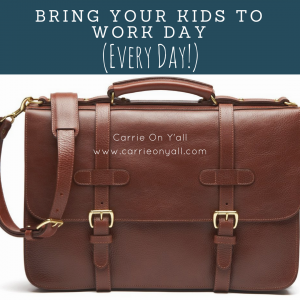I’m lucky enough to have experienced motherhood both as a working mom and one who now stays at home with my children. I was a high school English teacher for 11 years, the last 6 of those years in a Nashville, TN suburb.
My husband and I chose that particular suburb because the school system offered on-site daycare for teachers’ children in the school where I would be working. We were expecting our first child. We were new to parenting, but we also needed the money I would be making. And of course, as a 21st century mother, I knew I could do it all.
I secured the teaching job, and my children, for the next six years, were right down the hall from me. I saw their classes walking in the hallways, their classmates were my colleagues’ children, and their teachers were Early Childhood specialists, trained and hired by the same school system I worked in.
What’s more, the daycare’s tuition was subsidized by the school system, so we teachers paid exponentially less for better, on-site daycare.
I thought, “This is a perfect situation for me and my kids.” And then I thought, “This is a perfect situation for every company. Why isn’t everywhere like this?”
In 21st century America, we ask women to do it all. Be the doting wife, the perfect mother, the corporate executive, the ace housekeeper, the PTO volunteer, all while making organic meals, exercising constantly, and maintaining sanity. Sound about right? While women are expected to keep all those balls in the air (and look good doing it), there are ways that corporate America can make it easier for women to have a reasonable balance of their families, homes, and careers.
Admittedly, more and more companies are allowing flexible work hours and work-from-home scenarios, but there are still jobs where people just have to be present to win.
To that end, the system of on-site, cost-competitive daycare could and should become the standard in all large corporations and, frankly, in any place who can afford it. Why? I’ll give you a few reasons.
- The Female Element. Modern corporations know that having bright women on their teams is the smartest form of business, and in order to hire women, especially those young women who are starting careers and families (often simultaneously), those corporations need to find ways to make those women-who-want-it-all happy. Therefore, businesses should give them a place where they can have it all, a place where they can work hard and yet still have their children nearby. And of course, any employee (from the CEO to the custodial staff, dads, grandparents, and guardians) should be able to take advantage of this deal, too.
- The Financial Element. Many women choose to stay at home or postpone their careers for financial reasons, often because of the prohibitive costs of daycare. Bringing in subsidized daycare allows women to realize that they aren’t just working to pay the babysitter. They are earning a salary, contributing to the family’s financial bottom line, furthering their careers, and ensuring their children are well cared for all in one. On the corporate side, encouraging well-trained, hardworking women to work while their children are at an on-site daycare ensures a better, more-focused workforce.
- The Time Element. Providing on-site daycare allows women to be at work longer. Eliminating drive time to drop off and pick up children brings corporations more working hours from their staff. Period.
- The Teacher Element. Now more than ever, colleges are turning out Early Childhood Education specialists, people who have acquired associates or bachelors degrees and who specialize in teaching young children the basics, not just letters, numbers and colors, but also socialization, creativity, and problem-solving skills. Kids with working mothers are in better hands than ever before, and corporations can regulate their daycare operations just as they regulate their own employees.
- The Human Happiness Element. Juggling family and career is an ever-teetering balancing act. Guilt goes hand in hand with being a parent, and most working parents I know wish they could just have more… More hours in the day to keep the ship afloat, more time with their children, more ways to focus in the workplace and not be so torn. And this, this is a viable solution. Speaking from personal experience, having my children on-site made me a happy employee, increased my hours and productivity, and made me a more effective working mother knowing that I could be with my kids almost instantly if I needed or wanted to be.
The results, I believe, would increase the quality of corporations’ employees (those reliable parents who need to feed their kids) and a happier, more productive workforce.
Similarly for businesses, hiring daycare (and even after-school-care) staff for employees is much less expensive than hiring, training, and accounting for the learning curve of countless employees who decide leave a position because they’ve had children and quality daycare is so prohibitively expensive.
I would also argue that working mothers would be less likely to leave positions for another company if their current positions offer good, on-site childcare options. That, friends, is a benefit for both the business and the employee that is worth its weight in gold.
On-site daycare isn’t a viable option for every employer or employee in America, I realize, but it also doesn’t have to be a minority solution for a select few. On-site, cost-competitive daycare is a smart way to lure women back into the workforce and to retain those female employees who are already working.

[…] our daughter was born, I became a working mom… I was a high school English teacher in and around Nashville, TN for 11 years, but two […]